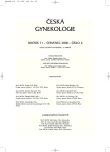Rapid Detection of Most Frequent Chromosomal Aneuploidies by the Multiplex QF PCR Method in the First Trimester of Pregnancy
Rychlá detekce nejčastějších chromozomálních aneuploidií metodou multiplex QF PCR v prvním trimestru gravidity
Cíl studie:
Rychlá detekce nejčastějších aneuploidií pomocí metody multiplex QF PCR na nekultivovaných vzorcích choriové tkáně. Shrnutí výsledků aplikace multiplex QF PCR v managmentu péče o těhotné ženy v prvním trimestru gravidity.
Typ studie:
Původní práce.
Název a sídlo pracoviště:
Ústav lékařské genetiky a fetální medicíny FN a LF UP, Olomouc.
Metodika:
Vzorky choriové tkáně byly získány od 101 gravidních žen. Nekultivované vzorky byly zpracovány metodou multiplex QF PCR. Analyzovány byly STR lokusy chromozomů 13, 18, 21 a X, Y. Tyto markery byly amplifikovány ve 2 oddělených multiplex PCR reakcích za stejných podmínek a podrobeny fragmentační analýze v kapilární elektroforéze.
Výsledky:
Všech 101 analyzovaných vzorků choriové tkáně bylo úspěšně amplifikováno. V tomto souboru bylo metodou multiplex QF PCR celkem detekováno 16 patologií u plodů. Ve dvou případech se jednalo o triploidii, v sedmi případech byla zachycena trizomie chromozomu 21 – Downův syndrom, v šesti případech pak trizomie chromozomu 18 – Edwardsův syndrom a jednou byla odhalena monozomie gonozomu X – Turnerův syndrom.
Závěr:
Metoda multiplex QF PCR je nedílnou součástí screeningu prvního trimestru a poskytuje rychle dostupný a spolehlivý výsledek u vyšetřovaných pacientek.
Klíčová slova:
aneuploidie, STR, multiplex PCR, screening prvního trimestru, prenatální diagnostika
Authors:
D. Vrbická; R. Vodička; R. Vrtěl; I. Dhaifalah; J. Šantavý
Authors‘ workplace:
Ústav lékařské genetiky a fetální medicíny FN a LF UP, Olomouc, přednosta prof. MUDr. J. Šantavý, CSc.
Published in:
Ceska Gynekol 2006; 71(4): 280-284
Category:
Original Article
Overview
Objective:
Rapid detection of most frequent aneuploidies by the multiplex QF PCR method in non-cultured samples of chorial tissue. Summarized results of QF PCR method applied in the management of care of pregnant women in the first trimester of pregnancy.
Type of study:
An original contribution.
Setting:
Institute of Medical Genetics and Fetal Medicine, Faculty Hospital and Medical Faculty, Palacky University Olomouc.
Methods:
The samples of chorial tissue were obtained from 101 pregnant women. Non-cultured samples were processed by the multiplex QF PCR method. STR loci of chromosomes 13, 18, 21 and X and Y were analyzed. These markers were amplified in two separate multiplex PCR reactions under the same conditions and subjected to fragmentation analysis in capillary electrophoresis.
Results:
All 101 analyzed samples of chorial tissue were successfully amplified. In this group, 16 pathologies of the fetuses were detected by the multiplex QF PCR method. Triploidy was detected in two cases, trisomy of chromosome 21 – Down syndrome was found in seven cases, and trisomy of chromosome 18 – Edwards syndrome was found in six cases and monosomy of gonosome X – the Turner’ s syndrome was revealed once.
Conclusions:
The multiplex QF PCR method is an indispensable part of the screening of the first trimester and provides a rapidly available and reliable result in the examined patients.
Key words:
aneuploidy, STR, multiplex PCR, first trimester screening, prenatal diagnostics
Labels
Paediatric gynaecology Gynaecology and obstetrics Reproduction medicineArticle was published in
Czech Gynaecology

2006 Issue 4
Most read in this issue
- Etiopathogenesis of the Prolapsed Vaginal Vault after Hysterectomy
- Actual Management of Pregnancies at Risk for Fetal Anemia
- Harmatoma of the Breast – Case Report
- Gynecological Aspects of Thyroid Disorders. A Review
